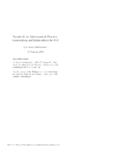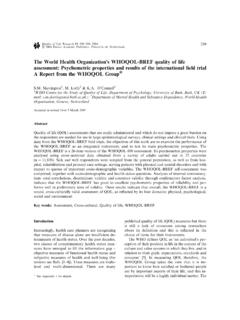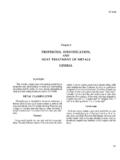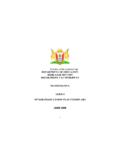Transcription of Progressions for the Common Core State Standards in ...
1 Progressions for the Common CoreState Standards in Mathematics (draft)c The Common Core Standards Writing Team21 April 2012 Draft, 4/21/2012, comment 5, Number andOperations in Base TenOverviewStudents work in the base-ten system is intertwined with their workon counting and cardinality, and with the meanings and propertiesof addition, subtraction, multiplication, and division. Work in thebase-ten system relies on these meanings and properties , but alsocontributes to deepening students understanding of base-ten system is a remarkably efficient and uni-form system for systematically representing all numbers. Using onlythe ten digits0,1,2,3,4,5,6,7,8,9, every number can be repre-sented as a string of digits, where each digit represents a value thatdepends on its place in the string. The relationship between valuesrepresented by the places in the base-ten system is the same forwhole numbers and decimals: the value represented by each placeis always10 times the value represented by the place to its imme-diate right.
2 In other words, moving one place to the left, the valueof the place is multiplied by10. In moving one place to the right,the value of the place is divided by10. Because of this uniformity,standard algorithms for computations within the base-ten system forwhole numbers extend to unitsEach place of a base-ten numeral represents abase-ten unit: ones, tens, tenths, hundreds, hundredths, etc. Thedigit in the place represents0to9of those units. Because tenlike units make a unit of the next highest value, only ten digits areneeded to represent any quantity in base ten. The basic unit isaone(represented by the rightmost place for whole numbers). Inlearning about whole numbers, children learn that ten ones com-pose a new kind of unit called aten. They understand two-digitnumbers as composed of tens and ones, and use this understandingin computations, decomposing1ten into10ones and composing aten power of the base-ten system is in repeated bundling byten:10tens make a unit called a hundred.
3 Repeating this process ofDraft, 4/21/2012, comment new units by bundling in groups of ten creates units calledthousand,ten thousand,hundred thousand.. In learning aboutdecimals, children partition a one into10equal-sized smaller units,each of which is a tenth. Each base-ten unit can be understood interms of any other base-ten unit. For example, one hundred can beviewed as a tenth of a thousand,10tens,100ones, or1 for operations in base ten draw on such relationshipsamong the base-ten algorithms for base-ten computations withthe four operations rely on decomposing numbers written in base-ten notation into base-ten units. The properties of operations thenallow any multi-digit computation to be reduced to a collection ofsingle-digit computations. These single-digit computations some-times require the composition or decomposition of a base-ten in Kindergarten, the requisite abilities develop grad-ually over the grades.
4 Experience with addition and subtractionwithin20is a Grade 1 fluency is a Grade and subtract within 20, demonstrating fluency for ad-dition and subtraction within 10. Use strategies such as countingon; making ten ( ,8682410414); decom-posing a number leading to a ten ( ,13413311019); using the relationship between addition and subtrac-tion ( , knowing that8412, one knows1284); andcreating equivalent but easier or known sums ( , adding67by creating the known equivalent66112113). within20that cross 10, such add and subtract within 20 using mental end of Grade 2, know from memory all sums of twoone-digit , are especially relevant to NBT because they afford thedevelopment of the Level 3 make-a-ten strategies for addition andsubtraction described in the OA Progression. From the NBT per-spective, make-a-ten strategies are (implicitly) the first instances ofcomposing or decomposing a base-ten unit. Such strategies are afoundation for understanding in Grade 1 that addition may requirecomposing a in Grade 2 that subtraction may within 100, including adding a two-digit number anda one-digit number, and adding a two-digit number and a multipleof 10, using concrete models or drawings and strategies basedon place value, properties of operations, and/or the relationshipbetween addition and subtraction; relate the strategy to a writ-ten method and explain the reasoning used.
5 Understand thatin adding two-digit numbers, one adds tens and tens, ones andones; and sometimes it is necessary to compose a a and subtract within 1000, using concrete models ordrawings and strategies based on place value, properties of op-erations, and/or the relationship between addition and subtrac-tion; relate the strategy to a written method. Understand thatin adding or subtracting three-digit numbers, one adds or sub-tracts hundreds and hundreds, tens and tens, ones and ones;and sometimes it is necessary to compose or decompose tens and algorithmsThe Standards distinguish strategiesfrom algorithms. For example, students use strategies for addition Computation set of predefined steps applicableto a class of problems that gives the correct result in every casewhen the steps are carried out correctly. See also: manipulations that may bechosen for specific problems, may not have a fixed order, andmay be aimed at converting one problem into another.
6 See also:computation subtraction in Grades K-3, but are expected to fluently addand subtract whole numbers using standard algorithms by the endof Grade 4. Use of the standard algorithms can be viewed as theculmination of a long progression of reasoning about quantities, thebase-ten system, and the properties of progression distinguishes between two types of computa-tional strategies: special strategies and general methods. For ex-ample, a special strategy for computing39817is to decompose17as215, and evaluate398215. Special strategies eithercannot be extended to all numbers represented in the base-ten sys-tem or require considerable modification in order to do so. A morereadily generalizable method of computing39817is to combinelike base-ten units. General methods extend to all numbers repre-sented in the base-ten system. A general method is not necessarilyefficient. For example, counting on by ones is a general method thatcan be easily modified for use with finite decimals.
7 General methodsbased on place value, however, are more efficient and can be viewedas closely connected with standard , 4/21/2012, comment practicesBoth general methods and special strate-gies are opportunities to develop competencies relevant to the NBTstandards. Use and discussion of both types of strategies offer op-portunities for developing fluency with place value and properties ofoperations, and to use these in justifying the correctness of computa-tions ( ). Special strategies may be advantageous in situationsthat require quick computation, but less so when uniformity is , they offer opportunities to raise the topic of using appropri-ate tools strategically ( ). Standard algorithms can be viewedas expressions of regularity in repeated reasoning ( ) used ingeneral methods based on place expressions and recordings of computations, whetherwith strategies or standard algorithms, afford opportunities for stu-dents to contextualize, probing into the referents for the symbolsinvolved ( ).
8 Representations such as bundled objects or mathdrawings ( , drawings of hundreds, tens, and ones) and diagrams( , simplified renderings of arrays or area models) afford the math-ematical practice of explaining correspondences among different rep-resentations ( ). Drawings, diagrams, and numerical recordingsmay raise questions related to precision ( ), , does that1represent1one or1ten? This progression gives examples of repre-sentations that can be used to connect numerals with quantities andto connect numerical representations with combination, composition,and decomposition of base-ten units as students work towards com-putational , 4/21/2012, comment Kindergarten, teachers help children lay the foundation for un-derstanding the base-ten system by drawing special attention learn to view the whole numbers11through19as ten onesand some more ones. They decompose10into pairs such as19,28,37and find the number that makes10when added to a givennumber such as3(see the OA Progression for further discussion).
9 And decompose numbers from 11 to 19 intoten ones and some further ones, , by using objects or draw-ings, and record each composition or decomposition by a drawingor equation ( , 18 = 10 + 8); understand that these numbersare composed of ten ones and one, two, three, four, five, six,seven, eight, or nine with numbers from 11 to 19 to gain foundations for use objects, math drawings, and equations Math drawings are simple drawings that make essential math-ematical features and relationships salient while suppressing de-tails that are not relevant to the mathematical describe, explore, and explain how the teen numbers, the count-ing numbers from11through19, are ten ones and some more can count out a given teen number of objects, ,12, andgroup the objects to see the ten ones and the two ones. It is alsoNumber-bond diagram and equation1 010771 0107717 = 10 + 71710710 strip5 stripNumber BondDrawinglayered place value cardslayeredseparatedfront:back:Figure 1:Decomposing 17 as 10 and 7 EquationDecompositions of teen numbers can be recorded with diagramsor to structure the ten ones into patterns that can be seen asten objects, such as two fives (see the OA Progression).
10 5- and 10-frames1 010771 0107717 = 10 + 71710710 strip5 stripNumber BondDrawinglayered place value cardslayeredseparatedfront:back:Figure 1:Decomposing 17 as 10 and 7 EquationChildren can place small objects into 10-frames to show the tenas two rows of five and the extra ones within the next 10-frame,or work with strips that show ten ones in a difficulty in the English-speaking world is that the words forteen numbers do not make their base-ten meanings evident. Forexample, eleven and twelve do not sound like ten and one and ten and two. The numbers thirteen, fourteen, fifteen, .. , nineteen reverse the order of the ones and tens digits by saying the onesdigit first. Also, teen must be interpreted as meaning ten andthe prefixes thir and fif do not clearly say three and five. Incontrast, the corresponding East Asian number words are ten one,ten two, ten three, and so on, fitting directly with the base-tenstructure and drawing attention to the role of ten.














